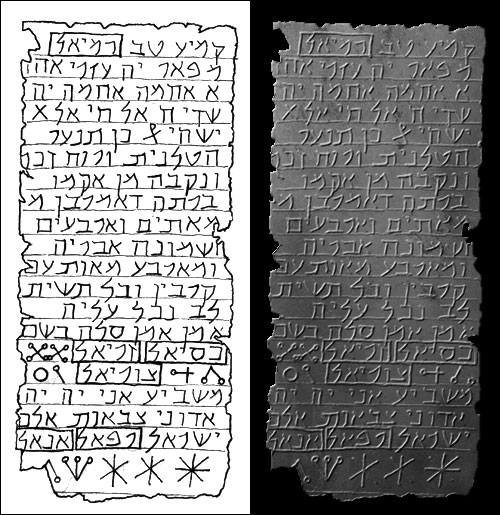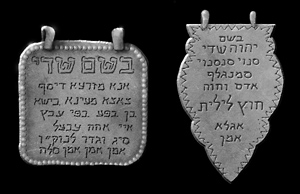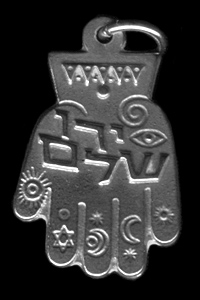Metal Amulets
First Published: 2008-01-18
Last Modified: 2008-01-18
Metal amulets that served similar functions as those of parchment were produced in a variety of shapes and styles, and, being less fragile, are more commonly encountered. They were worn as charms on necklaces, tied to the arm under the clothes, or wrapped up and carried on the person. They were usually silver (often of lower purity), in part because silver symbolized Hesed (Mercy), one of the ten sefirot, or emanations of God. Iron was sometimes used because it was believed to help drive away demons. Brass, copper, lead and gold examples exist, although copper and lead seem to be found more often in ancient foil examples and the use of gold is rare.
Metal amulets were usually made by a jeweler or silversmith who offered his creations to the general public, but was typically not a Torah scholar or master of the Kabbalah. It seems many of these well-intentioned people simply copied formulas they did not entirely understand onto their pieces, resulting in numerous errors. Schrire theorizes, based on the errors’ often phonetic nature, that many engravers “never read the sentence in its original form but had engraved it from memory as he had heard it dictated....one could hardly expect the amulet writer, still less an engraver of amulets to check his sources of reference.” (Schrire, 1966, p. 86). Some jewelers and engravers, however, may have worked under the direction of a scribe, scholar, or other expert.
While metal amulets, particularly those of higher quality, often contained most or all of the elements found in their parchment cousins, their texts tended to be shorter, more generalized, non-owner-specific, and make use of acronyms. Reasons for this include the smaller size, the difficult nature of the medium, and the production of multiple copies of a given piece. The more permanent and expensive nature of silver also probably influenced the content: if a person was only able to invest in one amulet, it was probably best for it to contain a "blanket statement" for protection and well-being.
Metal (Foil) Sheet Amulets
Among the oldest surviving metal amulets, dating to Late Antiquity, are those that were made out of thin, incised sheets of gold, silver, copper or lead, which were then carefully folded or rolled up and placed in a container. These fragile examples are rectangular or square, ranging from about 5cm (about 2 inches) to 7.5cm (about 3 inches) on a side (sometimes a little larger). They were typically made in Syria, Palestine, and Asia Minor. Unlike many later metal amulets which were worn as charms or pendants, foil amulets contain longer, more elaborate text and more closely resemble the parchment type. Joseph Naveh and Shaul Shaked picture, describe and translate over 20 examples, most from the 4th to 7th centuries C.E., in their book Amulets and Bowls: Aramaic Incantations of Late Antiquity.
Since I do not wish to violate copyright, instead of scanning an image I have created a pair of illustrations of what a metal sheet amulet looks like. Please note that the image below is not of a real amulet. It is a composite based on a variety of photographs and recorded texts in Naveh and Shaked's book.

The images show the composite amulet as a line drawing (left) and a simulation of what it would look like as metal (right) with characters inscribed in repousse (embossed, pushed out from the back—amulets of this type were also incised from the front). The model shows several common characteristics of sheet metal (foil) amulets, including fine horizontal lines between each row of text, angel names enclosed in boxes, and the addition of "angelic script" characters, the Xs, stars, triangular, and other geometric shapes with hollow circles at the ends of their lines. It calls upon God (by several Names) and a variety of angels to remove male and female "shadow spirits" from a particular woman.

This illustration is a more accurate representation of the size of a foil amulet. On a monitor with 72dpi resolution, it should appear to be about 1.5 inches wide and 3 inches long (newer or better monitors might display it smaller).
Pendants and Related Styles
Different regions were known for producing different amulet shapes and styles of script, and for using particular Names and verses. Common shapes include rectangular, scalloped triangular, circular, and pentagonal (usually a rectangle with a pointed top, somewhat house-shaped; some believe this was the shape of King David’s shield). Hexagrams (stars of David), hand shapes, and squares or rectangles with hinged "wings" attached are also known. There are also some examples of amulets shaped like knives, typically for women in childbirth to both “cut” labor pains and ward off the demoness Lilith—sometimes a woman kept an actual iron knife with her for this purpose while in labor.
Most of these designs include one or two loops at the top for hanging on a necklace, or loops at the corners for tying around the arm, though some are without, and are intended to be wrapped in cloth or leather and tucked into the clothing. Decoration was fairly sparse, typically a raised beaded or incised pattern around the edges. An image of a hand or hexagram might also appear.
Schrire (1966, pp. 43-45) describes a number of amulet styles based on region of origin:
- Afghanistan: Made of “thin but good” metal, they tend to be circular with large, square characters.
- Iraq: The use of angel names and magic squares is common. Saphardi-style cursive script is common with the notable exception of the 8-Letter Name of God being features in squared lettering. Amulet edges are reinforced.
- Italy: These are described as “very artistic and beautiful.” Usually Sheddai is the only Name of God featured.
- Kazakstan and Heart: Similar to Iraqi and Persian amulets but typically made of iron, not silver. The use of a character resembling a backward lower-case Y, representing suffix “el” found in angel names, is common.
- Kurdistan: These amulets are of a good metal quality with no decoration, but they make use of a “unique cursive script.”
- Morocco: The quality of silver used in these amulets is not as good as some others. They may feature Kabbalistic symbols and have small secondary pendants or ornaments hanging from their bottom edges.
- Persia: Persian metal amulets tend to be of a higher quality of silver, “boldly engraved” and contain fewer errors. Hebrew script is usually squared. A small flower appears at the center of some. A notable subtype was the Shiviti amulet. Large, thick, precisely and accurately inscribed, they all feature a superscription of Psalm 16:8 and the text “I have set the Lord always before me.” They also often make use of abbreviated versions of Psalm 67 (sometimes set in the shape of a menorah) and Genesis 49:22 (protection against the Evil Eye), the owner’s name, an occasionally pictures of beehives and scorpions.
- Turkey: Usually rectangular, heavy, and made of brass, they have no loops for hanging on a cord or chain (i.e.., they are made to be wrapped up and carried). Text is sparse.
Below are two examples of common silver metal amulet types. Since I do not wish to violate copyright laws, I've produced my own illustrations. Please note they do not represent actual amulets. They are "composite sketches" using shapes, text, and general themes I have encountered in a number of publications. They are meant to represent what an amulet could look like. The one on the left is meant to ward off the Evil eye and the one on the right contains the standard components for warding off Lilith.

If you would like to learn more about these types of amulets by examining actual examples, please see "Three Metal Amulets: Descriptions and Translations."
Hand of God
The Hand of God is a fine example of an amulet type which has survived to the present day as a good luck charm or simple symbol—it never occurred to me that it was an amulet or a descendant of amulets until I began my personal research. It is related to the Islamic Hand of Fatima, and originally served the same purpose: to thwart the Evil Eye and protect the wearer from malicious magic. The use of the Hand as an amulet recalls the phrases in the Torah (Exodus in particular) which refer to Hand of God as a metaphor for His being at work to punish wrongdoers and liberate the Jews.
One thing I have noticed is that the Islamic versions I've seen are very symmetrical, appearing to have two thumbs and index and ring fingers of equal height, while most Judaic versions are more life-like. Old Hands of God were often inscribed with the Name Sheddai or other Names. Modern versions, in my experience, are more decorative, sometimes adorned with stones. My mother's is gold and is a sort of filigree. Mine (which dates to around 1983) is silver and much more "mystical" in appearance, I suppose:

The text is simply the old Hebrew spelling of “Jerusalem” broken into two parts (the modern spelling is “Yerushalayim” and has a yod before the final mem). Curiously, if the raish (top segment, the second letter) is misread as a daled (and this is easy to do since the Hand is so small and the two letters differ mainly in that the daled has a sort of serif at the right-angle junction), it comes out as the words Yado Shalem which could be translated “His perfect hand.” I asked an Israeli friend if he thought whomever designed the thing was aware of that possible but oddly relevant misreading, leading his or her to choose the old-style (and rarely used in modern Hebrew) spelling of Jerusalem, but my friend thought perhaps the jeweler was just trying to be arty.
What the symbols mean (aside from the Star of David), if anything, I can only guess at; the eye is perhaps a ward against the Evil Eye. The crescent moon, in this case a waxing moon, was also said to protect against the Evil Eye, and seems to have been worn on its own in the form of an amulet called the Saharon.
Rings
Amuletic rings are not very common and seem to come from Bahgdad more than anywhere else. They tend to be silver, though some also have a stone, usually a protective red. They might have been inscribed with Names, and also names of the Patriarchs or prophets.
King Solomon, according to folklore, had a ring with the Name of God on it, which he used to summon and control demons. Rabbi Naphtali Katz of Poznan (d. 1718) was also said to have a ring engraved with Names, probably for use in exorcisms.
Ready for a few examples? You can see pictures of and read about three silver amulets and the messages on them in Three Metal Amulets: Descriptions and Translations.
Suggested Reading
If you enjoyed this article and want to learn more, I recommend:
Savedow, Steven. Sefer Rezial Hemelach (The Book of the Angel Rezial). Samuel Weiser, Inc., 2000. Full Listing »
Scholem, Gershom. Kabbalah. Keter Publishing House Jerusalem, Ltd., 1974. Full Listing »
Budge, Sir E. A. Wallis. Amulets and Superstitions. Dover, 1978. Full Listing »
Naveh and Shaked. Amulets and Magic Bowls: Aramaic Incantations of Late Antiquity. Magnes Press, Hebrew University, Jerusalem, 1985. Full Listing »
Schrire, T. Hebrew Amulets: Their Decipherment and Interpretation. Routledge and Kegan Paul, London, 1966. Full Listing »
Trachtenburg, Joshua. Jewish Magic and Superstition. Atheneum, 1987. Full Listing »
Gaster, Moses. "A Note on 'A Hebrew Amulet'", presented in Studies and Texts in Folklore, Magic, Mediaval Romance, Hebrew Apocrypha and Samaritan Archaeology, vol. 1. Maggs Brothers, London, 1925-1928. Full Listing »
For more titles on this and other topics, you may also wish to browse my annotated biblography for listings of all of my source texts, including descriptions and brief reviews.

